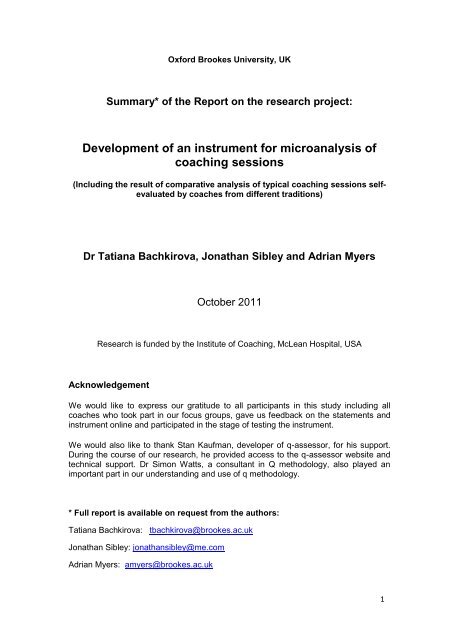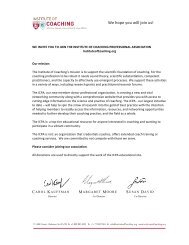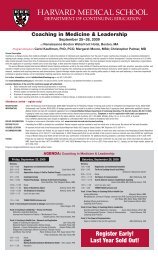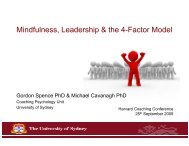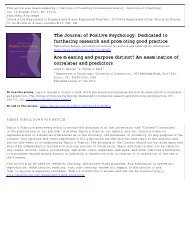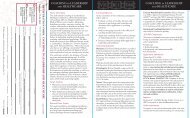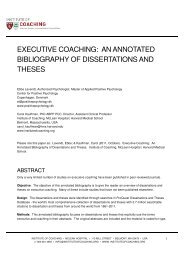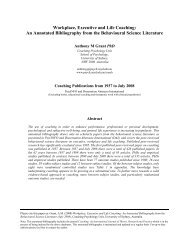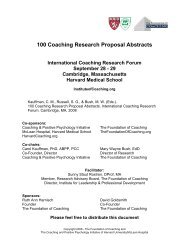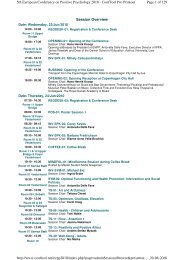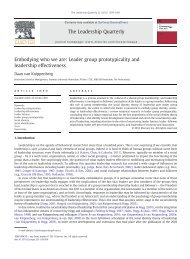Development of an Instrument for Microanalysis of Coaching Sessions
Development of an Instrument for Microanalysis of Coaching Sessions
Development of an Instrument for Microanalysis of Coaching Sessions
Create successful ePaper yourself
Turn your PDF publications into a flip-book with our unique Google optimized e-Paper software.
Ox<strong>for</strong>d Brookes University, UK<br />
Summary* <strong>of</strong> the Report on the research project:<br />
<strong>Development</strong> <strong>of</strong> <strong>an</strong> instrument <strong>for</strong> micro<strong>an</strong>alysis <strong>of</strong><br />
coaching sessions<br />
(Including the result <strong>of</strong> comparative <strong>an</strong>alysis <strong>of</strong> typical coaching sessions selfevaluated<br />
by coaches from different traditions)<br />
Dr Tati<strong>an</strong>a Bachkirova, Jonath<strong>an</strong> Sibley <strong>an</strong>d Adri<strong>an</strong> Myers<br />
October 2011<br />
Research is funded by the Institute <strong>of</strong> <strong>Coaching</strong>, McLe<strong>an</strong> Hospital, USA<br />
Acknowledgement<br />
We would like to express our gratitude to all particip<strong>an</strong>ts in this study including all<br />
coaches who took part in our focus groups, gave us feedback on the statements <strong>an</strong>d<br />
instrument online <strong>an</strong>d participated in the stage <strong>of</strong> testing the instrument.<br />
We would also like to th<strong>an</strong>k St<strong>an</strong> Kaufm<strong>an</strong>, developer <strong>of</strong> q-assessor, <strong>for</strong> his support.<br />
During the course <strong>of</strong> our research, he provided access to the q-assessor website <strong>an</strong>d<br />
technical support. Dr Simon Watts, a consult<strong>an</strong>t in Q methodology, also played <strong>an</strong><br />
import<strong>an</strong>t part in our underst<strong>an</strong>ding <strong>an</strong>d use <strong>of</strong> q methodology.<br />
* Full report is available on request from the authors:<br />
Tati<strong>an</strong>a Bachkirova: tbachkirova@brookes.ac.uk<br />
Jonath<strong>an</strong> Sibley: jonath<strong>an</strong>sibley@me.com<br />
Adri<strong>an</strong> Myers: amyers@brookes.ac.uk<br />
1
Why have we decided to do this research?<br />
One <strong>of</strong> the conditions <strong>for</strong> coaching to become a pr<strong>of</strong>essional discipline is the need to<br />
develop a body <strong>of</strong> knowledge <strong>an</strong>d research about our practice. This knowledge starts<br />
from the very central questions <strong>of</strong> what coaching actually is, what are the common<br />
elements among <strong>an</strong>d differences between existing types <strong>an</strong>d genres <strong>of</strong> coaching<br />
process <strong>an</strong>d what coaches do in comparison to other types <strong>of</strong> practices <strong>an</strong>d<br />
interventions.<br />
The International <strong>Coaching</strong> Research Forum in 2008 initiated a process that aimed at<br />
addressing these fundamental issues by encouraging researchers all over the world to<br />
become part <strong>of</strong> the research community. The researchers were challenged to address<br />
not only their personal interests in coaching but also explore the burning needs <strong>of</strong> the<br />
coaching field.<br />
One <strong>of</strong> the issues identified by the <strong>Coaching</strong> Research Forum in 2008 was a lack <strong>of</strong> a<br />
universal instrument that could describe the main elements <strong>of</strong> the coaching process<br />
<strong>an</strong>d allow the measurement <strong>of</strong> such elements in actual coaching sessions. A number<br />
<strong>of</strong> experienced <strong>an</strong>d internationally renowned researchers <strong>an</strong>d practitioners have<br />
suggested that there is a need <strong>for</strong> the development <strong>of</strong> a credible research instrument<br />
based on rigorous design, development <strong>an</strong>d testing. This instrument could describe<br />
the most generic <strong>an</strong>d diverse elements <strong>of</strong> a coaching session including actual<br />
coaching sessions <strong>an</strong>d ideal, prototypical sessions. The applications <strong>of</strong> such <strong>an</strong><br />
instrument could include different types <strong>of</strong> research, <strong>for</strong> example: comparing <strong>an</strong>d<br />
contrasting different coaching genres <strong>an</strong>d traditions, evaluating the effectiveness <strong>of</strong><br />
coaching process variables <strong>an</strong>d learning about the differences between practices <strong>of</strong><br />
experienced coaches <strong>an</strong>d novices. It could also be used in coaching training,<br />
supervision <strong>an</strong>d the continuing pr<strong>of</strong>essional development <strong>of</strong> coaches.<br />
There<strong>for</strong>e we decided to produce <strong>an</strong>d test such <strong>an</strong> instrument through thorough<br />
examination <strong>of</strong> the coaching process from the position <strong>of</strong> experts in this field. The<br />
research beg<strong>an</strong> with the review <strong>of</strong> literature relev<strong>an</strong>t to underst<strong>an</strong>ding coaching<br />
processes. Then we had to identify <strong>an</strong> appropriate methodology <strong>for</strong> this project <strong>an</strong>d to<br />
conduct it with the involvement <strong>of</strong> as m<strong>an</strong>y experienced coaches as possible. In the<br />
following sections we will describe how we developed the instrument <strong>an</strong>d what the<br />
results <strong>of</strong> initial application <strong>of</strong> it are.<br />
2
What is in the coaching literature?<br />
At the time <strong>of</strong> research the existing literature on coaching process was mainly<br />
theoretical. For example, through the use <strong>of</strong> imagined clients, Palmer <strong>an</strong>d Whybrow<br />
(2007) present the views <strong>of</strong> a diverse r<strong>an</strong>ge <strong>of</strong> expert coaches describing how they<br />
would facilitate a coaching session. A similar “how to” approach is taken in Stober <strong>an</strong>d<br />
Gr<strong>an</strong>t (2006). However, Lowm<strong>an</strong> (2005) argued that <strong>for</strong> recognition <strong>of</strong> coaching as a<br />
psychological discipline we need to carry out research <strong>of</strong> coaching process beyond<br />
case studies.<br />
Some research on coaching process beyond case study has been carried out in<br />
Germ<strong>an</strong>y (Greif et al, 2010; Grawe et al, 1994; Grawe, 2000; Gassm<strong>an</strong> & Grawe,<br />
2006; Behrendt, 2004; Schmidt & Thamm, 2008). For example, Greif et al (2010)<br />
developed a methodology <strong>for</strong> evaluating behaviours <strong>of</strong> the coach (e.g. Esteem <strong>an</strong>d<br />
emotional support, results oriented problem reflection, clarification <strong>of</strong> goals). These<br />
behaviors were assessed based on the observation by trained raters, when viewing<br />
recordings <strong>of</strong> coaching sessions. Although it was <strong>an</strong> import<strong>an</strong>t step in researching<br />
coaching process, the authors acknowledged the challenges presented in <strong>an</strong>alyzing<br />
complex behaviors. There instrument was also focused only on the behaviours <strong>of</strong> the<br />
coach.<br />
In the UK De Ha<strong>an</strong> <strong>an</strong>d colleagues (2010) researched signific<strong>an</strong>t moments that occur<br />
during coaching sessions. They explored differences <strong>an</strong>d similarities in perceptions <strong>of</strong><br />
signific<strong>an</strong>t moments <strong>for</strong> both coaches <strong>an</strong>d their clients. A signific<strong>an</strong>t finding in their<br />
study was that clients <strong>an</strong>d coaches both shared common perceptions <strong>of</strong> signific<strong>an</strong>t<br />
moments occurring in sessions. It could be argued, though, that however signific<strong>an</strong>t<br />
such critical moments c<strong>an</strong> be they do not represent the session as a whole, if we wish<br />
to create a comprehensive description <strong>of</strong> coaching processes during <strong>an</strong>y particular<br />
session.<br />
Another study <strong>of</strong> interest <strong>for</strong> <strong>an</strong>alyzing coaching process is by Stein (2009). Through<br />
<strong>an</strong>alysis <strong>of</strong> actual recordings <strong>of</strong> coaching sessions <strong>an</strong>d interviews Stein identified 16<br />
conversational identities typically employed by a coach (e.g. agenda facilitator,<br />
narrative listener, challenger, etc). It was <strong>an</strong> interesting approach <strong>an</strong>d a useful step to<br />
underst<strong>an</strong>ding how coaches work, however, the level <strong>of</strong> abstraction in these<br />
descriptions would make it difficult to evaluate a coaching session in detail.<br />
3
In summary, the literature on coaching process is mainly theoretical. The first steps<br />
towards underst<strong>an</strong>ding <strong>of</strong> the coaching process through research were made, however<br />
this type <strong>of</strong> research remained limited. In particularly, there seems to be a gap in the<br />
literature in terms <strong>of</strong> research aimed at <strong>an</strong>alyzing a whole coaching session that is a<br />
collaborative work between both the coach <strong>an</strong>d the client.<br />
What could be ‘borrowed’ in this regard from the studies on psychotherapy<br />
process?<br />
Much more has been done to underst<strong>an</strong>d helping process in our sister field <strong>of</strong><br />
psychotherapy (Rice <strong>an</strong>d Greenberg, 1984; Siegfried, 1995; Elliott, 2010). Although we<br />
could not use these studies in terms <strong>of</strong> the content, because our practices are<br />
different, we could benefit from learning about their methods <strong>of</strong> studies. Most <strong>of</strong> the<br />
methods that are used to <strong>an</strong>alyze psychotherapy process focus on specific behaviors<br />
or events occurring in a session or over a series <strong>of</strong> sessions rather th<strong>an</strong> provide <strong>an</strong><br />
<strong>an</strong>alysis <strong>of</strong> a whole session <strong>of</strong> therapy. However, one exception to this general<br />
approach has been the development <strong>an</strong>d application <strong>of</strong> the psychotherapy process Q-<br />
Set (PQS).<br />
The PQS is a set <strong>of</strong> 100 descriptors (items) designed to describe the session (Ablon &<br />
Jones, 1999). It is used to provide <strong>an</strong> <strong>an</strong>alysis <strong>of</strong> a whole therapy session <strong>an</strong>d to<br />
identify overall patterns <strong>of</strong> process. The PQS contains items relating to behaviors (<strong>of</strong><br />
client, therapist) as well as thoughts, feelings <strong>an</strong>d general patterns <strong>of</strong> interaction<br />
(Ablon & Jones, 1999).<br />
The PQS is based on Q Technique/ Q Methodology (e.g. Stephenson, 1935, 1953) in<br />
which particip<strong>an</strong>ts are typically asked to sort the items from most characteristic to least<br />
characteristic <strong>of</strong> the session. They r<strong>an</strong>k all items into a <strong>for</strong>ced distribution <strong>of</strong> around 11<br />
categories which allows only a few items to be placed at the extremities <strong>of</strong> the<br />
distribution. The r<strong>an</strong>king then c<strong>an</strong> be <strong>an</strong>alyzed statistically. A number <strong>of</strong> interesting<br />
studies was conducted using the prototypes <strong>of</strong> the sessions created by using this<br />
instrument (Ablon & Jones, 1998, 2001; Pole, Ablon, & O’Connor, 2008).<br />
The following table 1 illustrates that in psychotherapy research there are two traditions<br />
<strong>of</strong> using Q Methodology. One tradition (e.g. Stenner, Watts & Worrell, 2007; Brown, 1980)<br />
makes emphasis on the subjectivity involved in r<strong>an</strong>king the items. The other tradition<br />
(e.g. Block, 2008, Ablon & Jones, 1998, Shedler <strong>an</strong>d Westen, 1998) emphasise the potential<br />
4
to achieve some objectivity <strong>of</strong> measurement. The main differences are in the<br />
assumption that particip<strong>an</strong>ts c<strong>an</strong> be trained to a high level <strong>of</strong> inter-rater reliability <strong>an</strong>d<br />
that this is desirable in the interpretation <strong>of</strong> the findings. Both traditions have a track<br />
record <strong>of</strong> valuable research.<br />
Aspects <strong>of</strong> the<br />
research<br />
approach<br />
Aim <strong>of</strong><br />
Research<br />
Rationale<br />
underpinning<br />
development<br />
<strong>of</strong><br />
methodology<br />
Underlying<br />
philosophy<br />
<strong>Development</strong><br />
<strong>of</strong> <strong>an</strong> Initial list<br />
<strong>of</strong> items<br />
<strong>Development</strong><br />
<strong>of</strong> Q Set<br />
Traditional Q Methodology (e.g.<br />
Stenner, Watts & Worrell, 2007;<br />
Brown, 1980)<br />
To underst<strong>an</strong>d the position,<br />
viewpoints, feelings <strong>an</strong>d judgments <strong>of</strong><br />
specific groups <strong>of</strong> people about a<br />
topic <strong>of</strong> interest about which there are<br />
likely to be a diverse r<strong>an</strong>ge <strong>of</strong><br />
opinions (e.g. vases, conservation,<br />
leadership, metaphor usage on the<br />
internet)<br />
Methodological framework <strong>for</strong><br />
increasing certainty <strong>of</strong> capturing<br />
expressions <strong>of</strong> subjectivity; rejection<br />
<strong>of</strong> hypothetico-deductive tradition (in<br />
psychology, initially)<br />
Social Constructivist – assumes that<br />
the concourse <strong>of</strong> statements<br />
represents the broad discourses in<br />
area <strong>of</strong> interest; sets out to identify<br />
subjectivity (positions/ viewpoints<br />
with respect to these discourses)<br />
Typically based on gathering <strong>an</strong>d<br />
valuing a diverse r<strong>an</strong>ge <strong>of</strong> expressed<br />
opinions within the area <strong>of</strong> interest<br />
(c<strong>an</strong> be small sample) – items<br />
represent the concourse (r<strong>an</strong>ge <strong>of</strong><br />
ways <strong>of</strong> talking about/ expressing a<br />
domain <strong>of</strong> interest); part <strong>of</strong> this<br />
domain might include academic<br />
theory as elements <strong>of</strong> relev<strong>an</strong>t<br />
discourse; items could be other<br />
objects (e.g. pictures, odors, etc)<br />
A “craft skill” carried out by the<br />
researcher – items are broadly<br />
reflective <strong>of</strong> the concourse (not a<br />
representative sample); less concern<br />
about precise definitions <strong>an</strong>d<br />
ambiguities although some ef<strong>for</strong>t to<br />
minimize duplication; 40 – 60<br />
statements typical <strong>an</strong>d sufficient<br />
because the way particip<strong>an</strong>ts sort the<br />
items as configurations is what counts<br />
Application <strong>of</strong> Q-Technique (e.g. Block,<br />
2008, Ablon & Jones, 1998, Shedler<br />
<strong>an</strong>d Westen, 1998)<br />
To identify the critical elements <strong>of</strong><br />
variation within clinical practice (domain<br />
specificity); to generate prototypes<br />
representing diagnostic/ taxonomic<br />
categories or to describe therapeutic<br />
process; to provide measurements<br />
<strong>an</strong>d/or diagnostic assessments<br />
Lack <strong>of</strong> a common l<strong>an</strong>guage to describe<br />
personality <strong>an</strong>d psychotherapeutic<br />
process; need to make comparisons<br />
between theory (prototypes) <strong>an</strong>d<br />
practice; limitations <strong>of</strong> existing objective<br />
(O data) <strong>an</strong>d/or self report assessments<br />
(S data); limitations <strong>of</strong> outcome studies<br />
Rooted in a Positivist framework– strives<br />
to achieve consensual frameworks <strong>for</strong><br />
underst<strong>an</strong>ding <strong>an</strong>d describing therapeutic<br />
process <strong>an</strong>d typologies; strives to achieve<br />
inter-rater reliability, typical through<br />
m<strong>an</strong>uals <strong>an</strong>d training <strong>of</strong> particip<strong>an</strong>ts<br />
Experts generate the initial list strictly as a<br />
set <strong>of</strong> statements based on theoretical<br />
assumptions <strong>an</strong>d input from practitioners;<br />
also based on <strong>an</strong> extensive survey <strong>of</strong> the<br />
relev<strong>an</strong>t literature<br />
Methodical <strong>an</strong>d iterative process in which<br />
a reduced list <strong>of</strong> items is generated based<br />
on theoretical signific<strong>an</strong>ce, clarity <strong>of</strong><br />
underst<strong>an</strong>ding, careful avoid<strong>an</strong>ce <strong>of</strong><br />
duplication; consultation with experts;<br />
100 statements typical (200 <strong>for</strong> Shedler-<br />
Westen Assessment Procedure) <strong>an</strong>d<br />
import<strong>an</strong>t as individual items c<strong>an</strong> have<br />
clinical signific<strong>an</strong>ce (positive or negative<br />
correlation with a norm); need <strong>for</strong><br />
comprehensive coverage <strong>of</strong> specific<br />
5
Q Sorting<br />
Application <strong>of</strong><br />
Statistical<br />
Analysis <strong>an</strong>d<br />
interpretation<br />
Self-referential judgments (own views<br />
<strong>an</strong>d options but c<strong>an</strong> include the<br />
researcher assuming different<br />
positions)<br />
Used as a tool to provide a degree <strong>of</strong><br />
certainty about expressions <strong>of</strong><br />
subjectivity; the emergent factors<br />
are represented by factor<br />
exemplifying Q Sort/ factor arrays<br />
(weighted averages <strong>of</strong> those Q sorts<br />
that load onto each factor) which<br />
allow the interpretation <strong>of</strong> the factor<br />
by the researcher – the focus <strong>of</strong> the<br />
researcher is on the holistic<br />
interpretation <strong>of</strong> the factor<br />
exemplifying Q Sorts; a reading<br />
rather th<strong>an</strong> <strong>an</strong> objective truth<br />
elements <strong>of</strong> practice/ typology<br />
For psychotherapeutic process, carried<br />
out by trained observers (e.g. Jones,<br />
2000); subjective clinical judgment<br />
import<strong>an</strong>t but always in relation to a<br />
common underst<strong>an</strong>ding <strong>of</strong> the me<strong>an</strong>ing <strong>of</strong><br />
the items; <strong>for</strong> CAQ ; <strong>for</strong> CACQ <strong>an</strong>d<br />
SWAP, Q Sorting c<strong>an</strong> be done by non<br />
trained people but as a diagnostic tool or<br />
by trained assessors <strong>for</strong> research<br />
purposes<br />
As per the Stevenson approach; factor<br />
exemplifying Q Sorts are interpreted but<br />
in terms <strong>of</strong> diagnostic or descriptive<br />
categories; findings are replicated; the<br />
researcher is also interested in identifying<br />
individual items that are positively <strong>an</strong>d<br />
negatively correlated with a prototype (as<br />
individual items c<strong>an</strong> have clinical<br />
signific<strong>an</strong>ce) <strong>an</strong>d to check inter-rater<br />
agreement<br />
Table 1<br />
Summary <strong>of</strong> comparison between two major Q methodologies<br />
We decided that there is a clear benefit to the application <strong>of</strong> Q methodology in the field<br />
<strong>of</strong> coaching where there is much debate about definitions <strong>of</strong> coaching <strong>an</strong>d how it<br />
differs from related pr<strong>of</strong>essions. It is widely acknowledged that in coaching there are<br />
m<strong>an</strong>y traditions, genres <strong>an</strong>d much diversity in the contexts in which coaching takes<br />
place. A Q Set representing the broad domain <strong>of</strong> coaching would provide coaches the<br />
opportunity to express their positions on coaching session, actual or typically<br />
imagined.<br />
How we decided to approach this project?<br />
We were interested in how coaching practitioners conceptualize <strong>an</strong>d evaluate the<br />
coaching process, what they have in common <strong>an</strong>d how their original traditions<br />
influence differentiation between them. We also wished to create <strong>an</strong> instrument that<br />
could be used <strong>for</strong> collecting reasonably reliable data about a coaching session <strong>an</strong>d <strong>for</strong><br />
measuring signific<strong>an</strong>t aspects <strong>of</strong> the session. After signific<strong>an</strong>t discussion <strong>an</strong>d<br />
consideration <strong>of</strong> difficulties we decided to create <strong>an</strong> instrument that could be applicable<br />
6
<strong>for</strong> two different purposes: objective <strong>an</strong>alysis <strong>an</strong>d underst<strong>an</strong>ding <strong>of</strong> viewpoints. The<br />
appropriate application <strong>of</strong> the same Q set would be assured by different instructions <strong>for</strong><br />
each purpose.<br />
We also decided that focusing on specific elements <strong>of</strong> the session, however crucial,<br />
are not sufficient. We w<strong>an</strong>ted to create <strong>an</strong> instrument that represents the nature <strong>of</strong> the<br />
whole coaching session. This instrument should aim to underst<strong>an</strong>d the process <strong>of</strong> the<br />
session acknowledging the role <strong>of</strong> the coach, the client <strong>an</strong>d the dyad <strong>of</strong> coach <strong>an</strong>d<br />
client.<br />
How was the instrument developed?<br />
First <strong>of</strong> all we had to develop a comprehensive list <strong>of</strong> items describing the coaching<br />
process. We involved in this process as wide a circle <strong>of</strong> experienced coaching<br />
practitioners as possible to assure pr<strong>of</strong>essional credibility <strong>of</strong> this Q set. We started<br />
from creating the list <strong>of</strong> items individually. Then we discussed our lists between the<br />
three <strong>of</strong> us in the research team until we arrived at the agreement on how all items are<br />
<strong>for</strong>mulated. The main aim was <strong>for</strong> the items to differentiate between:<br />
<br />
<br />
<br />
styles / schools <strong>of</strong> coaching<br />
levels <strong>of</strong> coaching (beginner or experienced)<br />
coaching <strong>an</strong>d neighboring fields (e.g. counseling, consulting)<br />
The next step was to involve focus groups <strong>an</strong>d the wider coaching community. The<br />
focus groups were held in the UK, USA <strong>an</strong>d C<strong>an</strong>ada <strong>an</strong>d consisted <strong>of</strong> experienced<br />
coaches who also had <strong>an</strong> expertise in research or training <strong>of</strong> coaches. The first focus<br />
group met to explore the fit between the Q set created by us <strong>an</strong>d the description <strong>of</strong> the<br />
coaching process as they saw it. The group had <strong>an</strong> opportunity to use the presented Q<br />
set <strong>for</strong> evaluation <strong>of</strong> a video-recording <strong>of</strong> <strong>an</strong> actual coaching session. As a result <strong>of</strong> the<br />
whole day <strong>of</strong> activities <strong>an</strong>d discussions this group was able to identify statements that<br />
needed to be modified, added or removed from the initial list. After this focus group,<br />
researchers discussed all received suggestions <strong>an</strong>d made modifications to the Q set.<br />
This modified Q set <strong>for</strong>med a basis <strong>for</strong> a similar process with two other focus groups.<br />
The discussions <strong>of</strong> all three groups were audio-recorded, tr<strong>an</strong>scribed <strong>an</strong>d <strong>an</strong>alyzed.<br />
To involve a wider group <strong>of</strong> coaches in refining the instrument we created a dedicated<br />
website in which we invited coaches from all over the world to comment on the Q sort<br />
7
that consisted at that time <strong>of</strong> 80 items describing a coaching session. 207 visitors from<br />
26 countries visited the site 344 times <strong>an</strong>d left 167 comments. We used this feedback<br />
to make further adjustments to the Q set.<br />
What was our final Q set?<br />
Both focus groups <strong>an</strong>d the final stage <strong>of</strong> gathering wider feedback produced a<br />
signific<strong>an</strong>t amount <strong>of</strong> material that we <strong>an</strong>alyzed using thematic <strong>an</strong>alysis. M<strong>an</strong>y themes<br />
have emerged that influenced signific<strong>an</strong>tly every decision about the final Q set. The<br />
<strong>an</strong>alysis showed that it is possible to arrive at a set <strong>of</strong> items that is sufficiently<br />
comprehensive; focused on process rather th<strong>an</strong> content <strong>an</strong>d <strong>for</strong>mulated in l<strong>an</strong>guage<br />
acceptable <strong>for</strong> coaches from m<strong>an</strong>y different orientations.<br />
The instructions <strong>for</strong> using the instrument were also developed as the result <strong>of</strong> this<br />
<strong>an</strong>alysis (please, see Appendix A) <strong>for</strong> two sets <strong>of</strong> instructions developed. One set<br />
could be used if the instrument is applied <strong>for</strong> evaluating imagined typical session <strong>an</strong>d<br />
the second set is designed <strong>for</strong> evaluation <strong>of</strong> actual observed session.<br />
The following table 2 is our final list <strong>of</strong> items that we call CPQS (<strong>Coaching</strong> Process Q<br />
Set).<br />
Item’s<br />
Items<br />
Number<br />
1 There is <strong>an</strong> exploration <strong>of</strong> the effect <strong>of</strong> client's choice <strong>of</strong> words<br />
2 There is <strong>an</strong> exploration <strong>of</strong> the client's values<br />
3 There is <strong>an</strong> exploration <strong>of</strong> the client's environmental influences (e.g.,<br />
org<strong>an</strong>izational, family, politics, history)<br />
4 There is <strong>an</strong> exploration <strong>of</strong> the client's underlying mindset (e.g., assumptions,<br />
beliefs, stories)<br />
5 Coach <strong>an</strong>d client explore the deeper me<strong>an</strong>ing <strong>of</strong> a presenting issue<br />
6 Coach works with the client's apparent defensiveness<br />
7 Coach points out recurrent theme in client's behavior<br />
8 Coach points out potential unconscious motives <strong>of</strong> the client (out <strong>of</strong> the client's<br />
awareness)<br />
9 There is <strong>an</strong> exploration <strong>of</strong> the client's in session non-verbal behavior<br />
10 Coach invites client to consider other people's perspectives on <strong>an</strong> issue<br />
11 Coach initiates exploration <strong>of</strong> client's resources <strong>an</strong>d how they might be<br />
leveraged (including strengths, accomplishments, <strong>an</strong>d/or external resources)<br />
12 Coach explores client’s emotions<br />
13 Coach encourages client to feel more deeply within session<br />
14 Coach encourages client to become more aware <strong>of</strong> his immediate experience in<br />
the session<br />
8
15 Coach challenges client's perspective <strong>of</strong> situation <strong>an</strong>d/or self<br />
16 Coach asks client to qu<strong>an</strong>tify feeling / perception / issue using a scale<br />
17 There is one or more periods <strong>of</strong> silent reflection<br />
18 There is a discussion <strong>of</strong> the results <strong>of</strong> a psychometric instrument<br />
19 There is a discussion <strong>of</strong> external feedback<br />
20 Coach gives feedback from coach’s experience <strong>of</strong> client<br />
21 Coach discloses own feelings/ bodily sensations evoked in the session<br />
22 There appears to be a productive use <strong>of</strong> metaphors<br />
23 Coach <strong>an</strong>d client explore their differences in perception <strong>of</strong> the situation<br />
24 Coach exp<strong>an</strong>ds on client's statements<br />
25 Coach provides reassur<strong>an</strong>ce to client<br />
26 Coach uses humor<br />
27 Coach shows empathy<br />
28 Coach shares personal details about herself<br />
29 Coach discloses own fallibility<br />
30 There appears to be rapport (strong connection) between client <strong>an</strong>d coach<br />
31 Coach <strong>an</strong>d client appear to underst<strong>an</strong>d each other<br />
32 Coach <strong>an</strong>d client discuss their relationship<br />
33 Coach asks <strong>for</strong> permission to give feedback<br />
34 Coach repeats client's words back to him<br />
35 Coach paraphrases the client's statements<br />
36 Coach checks if her underst<strong>an</strong>ding is correct<br />
37 There is a sense <strong>of</strong> optimism in the coaching session<br />
38 There appears to be a shift in energy during the coaching session<br />
39 Coach <strong>an</strong>d client appear to be engaged (vs. disengaged)<br />
40 Coach follows up on key / signific<strong>an</strong>t statements made by client<br />
41 Coach asks questions helping the client to elaborate<br />
42 There is a discussion <strong>of</strong> the coaching “contract”<br />
43 There is a discussion <strong>of</strong> issues related to the termination <strong>of</strong> coaching<br />
44 There is a discussion <strong>of</strong> boundaries <strong>an</strong>d/or ethical issues related to the coaching<br />
engagement<br />
45 There is a discussion <strong>of</strong> a potential referal to <strong>an</strong> outside specialist (e.g.,<br />
therapist, doctor, fin<strong>an</strong>cial advisor)<br />
46 The session is fast-paced<br />
47 The session appears highly structured<br />
48 Coach <strong>an</strong>d client appear to bring the session to closure easily<br />
49 Coach <strong>an</strong>d client discuss the process <strong>of</strong> the session<br />
50 Coach takes <strong>an</strong> active role during the session<br />
51 Coach makes explicit a shift in role during the session (e.g., acting as consult<strong>an</strong>t,<br />
teacher, therapist)<br />
52 Coach explains the reason behind using a specific intervention<br />
53 Coach appears to be using <strong>an</strong> intervention mech<strong>an</strong>istically<br />
54 Coach appears to be pursuing her own agenda<br />
55 Client takes initiative in structuring the session<br />
56 There is a discussion <strong>of</strong> client's feedback on coaching<br />
57 Coach makes sounds or non-verbally encourages client to continue<br />
9
58 Coach is verbose<br />
59 Coach interrupts client<br />
60 Client interrupts coach<br />
61 Coach suggests in-session exercise / activity<br />
62 Coach broadens the focus <strong>of</strong> discussions<br />
63 Coach asks questions that appear to open new possibilities <strong>for</strong> the client<br />
64 Coach appears to focus on a third-party's agenda (e.g., org<strong>an</strong>ization, partner,<br />
parents)<br />
65 Client suggests his next course <strong>of</strong> action<br />
66 There is a discussion <strong>of</strong> new practices <strong>for</strong> the client<br />
67 Coach <strong>of</strong>fers possible solutions<br />
68 Coach suggests homework <strong>for</strong> client<br />
69 Coach shares her knowledge about topic<br />
70 Coach gives advice<br />
71 Coach follows up on previous homework<br />
72 Coach encourages client to make choices<br />
73 Coach asks the client to describe key learnings / take-aways from session<br />
74 There is a discussion <strong>of</strong> the client's progress<br />
75 There is a discussion about the client’s overall goals<br />
76 There is a discussion about how to measure the success <strong>of</strong> the coaching<br />
engagement<br />
77 Coach redirects client to client’s agenda<br />
78 Coach explores client's level <strong>of</strong> engagement in coaching<br />
79 Coach inquires about client's aim <strong>for</strong> the session<br />
80 There is a discussion <strong>of</strong> the client's impact on his environment (e.g.,<br />
org<strong>an</strong>ization, family)<br />
Table 2 The <strong>Coaching</strong> Process Q Set (CPQS)<br />
How we applied the developed instrument <strong>for</strong> comparing differences <strong>an</strong>d<br />
similarities between the elements <strong>of</strong> coaching sessions conducted by coaches<br />
from various school/traditions?<br />
From two choices <strong>of</strong> using the instrument we decided this time not to use it <strong>for</strong><br />
observed actual sessions but to compare how practitioners who coach according to<br />
different schools/types/traditions describe their own typical imagined session using this<br />
instrument. We believed that this study could contribute to the debates about a<br />
definition <strong>of</strong> coaching that is still <strong>an</strong> unresolved issue (Cox, et al, 2010; Bachkirova <strong>an</strong>d<br />
Kauffm<strong>an</strong>, 2009; Sherm<strong>an</strong> & Reas, 2004; Kilburg, 1996, Ferrar, 2004). One <strong>of</strong> us<br />
actually argued in 2009 that it is impossible to find a suitable definition <strong>of</strong> coaching on<br />
the basis <strong>of</strong> the process because <strong>of</strong> the immeasurable variety <strong>of</strong> coaching schools,<br />
traditions, theories, models or practical considerations (Bachkirova <strong>an</strong>d Kauffm<strong>an</strong>,<br />
10
2009). This research could show if this argument could be supported. However, if<br />
there are more similarities th<strong>an</strong> differences in the process <strong>of</strong> coaching it could help us<br />
to make a step towards a definition <strong>of</strong> coaching on the basis <strong>of</strong> its process.<br />
With this purpose we invited coaches to take part in this research by <strong>an</strong>nouncing this<br />
opportunity in m<strong>an</strong>y <strong>for</strong>ums <strong>an</strong>d newsletter <strong>of</strong> pr<strong>of</strong>essional bodies. We asked them to<br />
use the instrument to describe one <strong>of</strong> their own typical mid engagement coaching<br />
session. 41 coaches from 5 countries agreed to participate. When asked about their<br />
primary school or tradition <strong>of</strong> coaching their <strong>an</strong>swer varied from ‘mixed’ to more<br />
specific such as CTI, Gestalt, brain-based, existential, person-centered, <strong>an</strong>d<br />
appreciative inquiry. They were directed through our website http://www.coachingprocess.org<br />
to the website on www.q-assessor.com to complete <strong>an</strong> online q-sort using<br />
the final Q sort.<br />
Particip<strong>an</strong>ts were directed to place the items into 3 categories – characteristic, neutral,<br />
<strong>an</strong>d uncharacteristic. Following this, they were directed to place each item into one <strong>of</strong><br />
11 categories using a fixed distribution with fewer items at the extremes <strong>an</strong>d a greater<br />
number in the more central categories. Categories r<strong>an</strong>ged in size from 2 items at each<br />
extreme to 14 items in the central category. This process is intended to encourage<br />
particip<strong>an</strong>ts to make clear discriminations between items.<br />
What did we find?<br />
In order to underst<strong>an</strong>d the data as comprehensibly as possible, we applied Q-mode<br />
factor <strong>an</strong>alysis <strong>an</strong>d qualitative <strong>an</strong>alysis <strong>of</strong> particip<strong>an</strong>ts’ feedback. Factor <strong>an</strong>alysis allows<br />
to underst<strong>an</strong>d competing viewpoints on how the session is described <strong>an</strong>d to identify<br />
groups <strong>of</strong> particip<strong>an</strong>ts who see their session in a similar way (a full description <strong>of</strong> the<br />
methods <strong>of</strong> <strong>an</strong>alysis is available directly from the authors).<br />
The <strong>an</strong>alysis revealed that only one signific<strong>an</strong>t factor could be determined suggesting<br />
one overall common perspective shared about how to describe a coaching session. As<br />
one might expect, there are some individual differences despite <strong>an</strong> apparently strong<br />
overall consensus. Coaches seemed to agree more strongly about items they consider<br />
uncharacteristic <strong>of</strong> coaching th<strong>an</strong> about those items that they consider characteristic.<br />
In the Appendix B you c<strong>an</strong> see most characteristic <strong>an</strong>d least characteristic items<br />
representing this factor in the <strong>for</strong>m <strong>of</strong> a factor array intended to illustrate the factor. The<br />
11
fact that coaches could achieve consensus in terms <strong>of</strong> how to describe a typical<br />
coaching session suggests that there are common elements occurring in a coaching<br />
session that c<strong>an</strong> be described in non theoretical terms.<br />
Our next step was to interpret the factor array (patterns in this overall description <strong>of</strong> a<br />
typical coaching session). Each suggested pattern is presented next by a group <strong>of</strong><br />
items showing the statement number in the Q set (e.g. Item 63) <strong>an</strong>d a score (e.g. +4 or<br />
-3) that indicates how characteristic (+5 is the highest score) or uncharacteristic (-5 is<br />
the lowest score) that statement was in this overall description <strong>of</strong> a typical coaching<br />
session. We interpreted each pattern as a Gestalt which gives some ideas <strong>of</strong> how a<br />
typical coaching session look like from the shared point <strong>of</strong> view <strong>of</strong> the participated<br />
coaches.<br />
Interpretation <strong>of</strong> Factor Array<br />
The viewpoint expressed in the factor array is that coaching is about firmly being <strong>of</strong><br />
service <strong>of</strong> the concerns <strong>of</strong> the client:<br />
Item 54 Coach appears to be pursuing her own agenda -5 (ie., highly<br />
uncharacteristic)<br />
Item 64 Coach appears to focus on a third-party’s agenda. -4<br />
Item 79: Coach inquires about client’s aim <strong>for</strong> the session +4<br />
Item 75 There is a discussion about the client’s overall goals +3<br />
Within this service context, the role <strong>of</strong> the coach is to ask questions <strong>an</strong>d to work with<br />
the sense making processes <strong>an</strong>d worldview <strong>of</strong> the client rather th<strong>an</strong> from her own or<br />
others’ frame <strong>of</strong> reference:<br />
Item 41 Coach asks questions helping the client to elaborate +5<br />
Item 40 Coach follows up on key/signific<strong>an</strong>t statements made by the client<br />
+2<br />
Item 58 Coach is verbose -4 (i.e. there is a focus on letting the client talk)<br />
Item 2 There is <strong>an</strong> exploration <strong>of</strong> the client’s values +3<br />
Item 70 Coach gives advice -4 (i.e. Does not give own worldview)<br />
12
The coaching session is considered to be fluid <strong>an</strong>d absorbing but not fast paced:<br />
Item 47 The session appears highly structured -4<br />
Item 39 Coach <strong>an</strong>d client appear to be engaged +3<br />
Item 46 The session is fast-paced -3<br />
Elements <strong>of</strong> the session which might disrupt “flow” (Czikszentmihalyi, 1991) tend to be<br />
minimized:<br />
Item 53 Coach appears to be using <strong>an</strong> intervention mech<strong>an</strong>istically -5<br />
Item 51 Coach makes explicit a shift in role during the session -2<br />
Item 17 There is one or more periods <strong>of</strong> silent reflection +1<br />
Item 52 Coach explains the reason behind using a specific intervention 0<br />
A sense <strong>of</strong> hope <strong>an</strong>d positivity is also evident in a typical session:<br />
Item 63 Coach asks questions that appear to open new possibilities <strong>for</strong> the<br />
client +5<br />
Item 37 There is a sense <strong>of</strong> optimism in the coaching session +3<br />
High value is given to the import<strong>an</strong>ce <strong>of</strong> connection, warmth, underst<strong>an</strong>ding <strong>an</strong>d<br />
respect:<br />
Item 30 There appears to be rapport (strong connection) +4<br />
Item 36: Coach checks if her underst<strong>an</strong>ding is correct +3<br />
Item 27 Coach shows empathy +4<br />
Item 59 Coach interrupts client -3<br />
Item 60 Client interrupts coach -3<br />
Item 31 Coach <strong>an</strong>d client appear to underst<strong>an</strong>d each other +2<br />
On the whole, what seems to be the most characteristic <strong>of</strong> a typical coaching session<br />
from the views expressed by the extended group <strong>of</strong> coaches could be summarized in<br />
the following way: A typical coaching session was perceived to be a client focused <strong>an</strong>d<br />
fluid process in which the coach <strong>an</strong>d client explore the worldview <strong>of</strong> the client in the<br />
context <strong>of</strong> <strong>an</strong> engaging <strong>an</strong>d respectful relationship holding positive expectations.<br />
13
It is also import<strong>an</strong>t to explore what types <strong>of</strong> events were not considered characteristic<br />
<strong>of</strong> a typical coaching session. This may be because these events, while clearly <strong>of</strong><br />
signific<strong>an</strong>ce in some coaching sessions, are not common in a typical coaching session<br />
(De Ha<strong>an</strong>, 2010).<br />
Item 45 There is discussion <strong>of</strong> a potential referral to <strong>an</strong> outside specialist<br />
(e.g., therapist, doctor, fin<strong>an</strong>cial advisor) -3<br />
Item 43 There is a discussion <strong>of</strong> issues related to the termination <strong>of</strong><br />
coaching -3<br />
Item 44 There is a discussion <strong>of</strong> boundaries <strong>an</strong>d/or ethical issues related to<br />
the coaching engagement -2<br />
Item 78 Coach explores client’s level <strong>of</strong> engagement in coaching -2<br />
There also seemed to be <strong>an</strong> aversion to considering coaching as a process <strong>of</strong><br />
uncovering unconscious motivations or feelings as in some therapeutic contexts or<br />
particular traditions <strong>of</strong> coaching:<br />
Item 8 Coach points out potential unconscious motives <strong>of</strong> the client (out <strong>of</strong><br />
client’s awareness) -2<br />
Item 6 Coach works with client’s apparent defensiveness -2<br />
Item 13 Coach encourages client to feel more deeply within session -3<br />
Item 21 Coach discloses own feelings/bodily sensations evoked in the<br />
session -2<br />
Related to this is a possible aversion to the use <strong>of</strong> psychometric instruments, which<br />
also typically seek to classify or probe into the “psyche” <strong>of</strong> the client:<br />
Item 18 There is a discussion <strong>of</strong> the results <strong>of</strong> a psychometric instrument -2<br />
Together items 8, 6, 13 <strong>an</strong>d 18 (above) could be indicative <strong>of</strong> a view that coaching is<br />
not a process <strong>of</strong> stretching into the “inner psyche” <strong>of</strong> the client with privileged<br />
knowledge owned by the coach. However, this does not me<strong>an</strong> that me<strong>an</strong>ing or<br />
behavioural patterns c<strong>an</strong>not be explored in a more conscious m<strong>an</strong>ner in which both<br />
have access to underst<strong>an</strong>ding <strong>of</strong> the issue:<br />
Item 5 Coach <strong>an</strong>d client explore the deeper me<strong>an</strong>ing <strong>of</strong> a presenting issue<br />
+2<br />
14
Item 15 Coach challenges client’s perspective <strong>of</strong> situation <strong>an</strong>d/or self +2<br />
Item 7 Coach points out recurrent theme in client’s behaviour +2<br />
The placing <strong>of</strong> some <strong>of</strong> the statements towards the middle <strong>of</strong> the distribution is also <strong>of</strong><br />
interest. M<strong>an</strong>y <strong>of</strong> these ratings c<strong>an</strong> be understood in the context <strong>of</strong> some <strong>of</strong> the main<br />
themes already outlined. For example, if coaching is perceived as a process <strong>of</strong><br />
focusing firmly on the needs <strong>of</strong> the client <strong>an</strong>d doing this in a m<strong>an</strong>ner that shows<br />
respect <strong>an</strong>d empathy, then it follows that activities that might highlight the client’s<br />
accountability become relatively less import<strong>an</strong>t. Underst<strong>an</strong>ding the client <strong>an</strong>d working<br />
to his own agenda appear to be more import<strong>an</strong>t th<strong>an</strong> his speed <strong>of</strong> progress:<br />
Item 72 Coach encourages client to make choices +1<br />
Item 74 There is discussion <strong>of</strong> the client’s progress +1<br />
Item 77 Coach redirects client to client’s agenda 0<br />
Item 71 Coach follows up on previous homework +2<br />
Some items occupying a mid-r<strong>an</strong>ge position also seem to shift the focus from the<br />
issues <strong>of</strong> the client:<br />
Item 3 There is <strong>an</strong> exploration <strong>of</strong> the client’s environmental influences (e.g.<br />
org<strong>an</strong>izational, family, politics, history) 0<br />
Item 80 There is a discussion <strong>of</strong> the client’s impact on his environment (e.g.<br />
org<strong>an</strong>ization, family) 0<br />
Item 10 Coach invites client to consider other people’s perspectives +1<br />
Item 19 There is a discussion <strong>of</strong> external feedback -1<br />
Item 20 Coach gives feedback from coach’s experience <strong>of</strong> client +1<br />
Item 23 Coach <strong>an</strong>d client explore their differences in perception <strong>of</strong> the<br />
situation 0<br />
Item 24 Coach exp<strong>an</strong>ds on client’s statements +1<br />
Item 29 Coach discloses own fallibility-1<br />
Item 33 Coach asks <strong>for</strong> permission to give feedback 0<br />
Item 50 Coach takes <strong>an</strong> active role in the session 0<br />
15
Item 62 Coach broadens the focus <strong>of</strong> discussions 0<br />
Together these items tend to consider perspectives <strong>an</strong>d issues beyond the centrality <strong>of</strong><br />
the worldview <strong>of</strong> the client. Items which scored higher (<strong>an</strong>d as already listed above)<br />
tended to be much more centred on the client, e.g.:<br />
Item 41 Coach asks questions helping the client to elaborate +5 (i.e from<br />
the client’s perspective)<br />
Item 63 Coach asks questions that appear to open new possibilities <strong>for</strong> the<br />
client +5 (i.e. starting from the client’s worldview)<br />
Other mid-r<strong>an</strong>ging scores tended to depersonalise/qu<strong>an</strong>tify the client in the same way<br />
that statements relating to the use <strong>of</strong> psychometric instruments or the exploration <strong>of</strong><br />
unconscious process might also do (which were scored negatively):<br />
Item 16 Coach asks client to qu<strong>an</strong>tify feeling/perception/ issue using a scale<br />
-1<br />
This thematic exploration <strong>of</strong> the viewpoint <strong>of</strong> the extended group <strong>of</strong> coaches suggests<br />
a broadly hum<strong>an</strong>istic orientation in which events relating to disruptions in the<br />
relationship would not be considered as typical. This viewpoint is not compatible with<br />
the coach assuming <strong>an</strong> authoritative or directive position. An equal rejection was<br />
expressed towards using methods or discussion topics that tended to depersonalize<br />
clients or draw them away from their personal orientation towards their own world.<br />
What does this me<strong>an</strong> in relation to defining coaching?<br />
Taking into consideration some limitations <strong>of</strong> the process <strong>of</strong> sorting <strong>an</strong>d the size <strong>of</strong> the<br />
sample (please, see a comprehensive discussion <strong>of</strong> limitations in the full report) we<br />
believe that the result <strong>of</strong> the study may be indicative <strong>of</strong> a broad consensus across<br />
coaching practitioners about what typically happens in a typical coaching session in<br />
spite <strong>of</strong> signific<strong>an</strong>t differences in their theoretical orientations <strong>an</strong>d traditions. Although<br />
we were expecting to find more differences th<strong>an</strong> similarities between different groups<br />
<strong>of</strong> coaches who described their typical coaching session the findings <strong>of</strong> this study did<br />
not confirm this expectations.<br />
This suggests the potential to create a ‘good enough’ definition <strong>of</strong> coaching. It appears<br />
that a typical coaching session is perceived to be a client-focused <strong>an</strong>d fluid process in<br />
16
which the coach <strong>an</strong>d client explore the worldview <strong>of</strong> the client in the context <strong>of</strong> <strong>an</strong><br />
engaging <strong>an</strong>d respectful relationship holding positive expectations.<br />
What are our conclusions?<br />
We fulfilled the aim <strong>of</strong> this project to create <strong>an</strong> instrument that could be used <strong>for</strong><br />
describing both <strong>an</strong> actual observed coaching session <strong>an</strong>d <strong>an</strong> imagined typical session.<br />
At m<strong>an</strong>y stages <strong>of</strong> the process we received signific<strong>an</strong>t amount <strong>of</strong> qualitative feedback<br />
from various groups <strong>of</strong> particip<strong>an</strong>ts. On the one h<strong>an</strong>d this feedback suggested that<br />
CPQS is sufficiently comprehensive <strong>an</strong>d allows coaches from various backgrounds,<br />
schools <strong>an</strong>d orientations to describe <strong>an</strong>d evaluate coaching process. On the other<br />
h<strong>an</strong>d the <strong>an</strong>alysis <strong>of</strong> their feedback allowed us to make m<strong>an</strong>y ch<strong>an</strong>ges in the<br />
instrument in order to improve it.<br />
At the same time we expect this instrument to evolve over time, as researchers use<br />
the instrument <strong>an</strong>d identify missing items, redund<strong>an</strong>t items, <strong>an</strong>d items that might be<br />
clarified. We <strong>an</strong>ticipate that, there could be future versions <strong>of</strong> this instrument, as<br />
additional use in the field c<strong>an</strong> help to refine the list <strong>of</strong> items. It may also be useful,<br />
going <strong>for</strong>ward, to create a m<strong>an</strong>ual that describes each item in greater detail, giving<br />
examples <strong>of</strong> how it might be interpreted when rated as “highly characteristic” or “highly<br />
uncharacteristic”.<br />
The application <strong>of</strong> the instrument <strong>for</strong> describing <strong>an</strong> imagined typical coaching session<br />
by 41 coaches demonstrated a strong consensus in the way coaching sessions are<br />
described. The fact that a r<strong>an</strong>dom sample <strong>of</strong> coaches sorted the items in the same<br />
way indicates that a generic definition <strong>of</strong> coaching is possible. The study indicates <strong>an</strong><br />
actual set <strong>of</strong> the elements <strong>of</strong> the session that could <strong>for</strong>m a base <strong>of</strong> a definition <strong>of</strong><br />
coaching.<br />
The instrument may be used <strong>for</strong> potential research comparing coaching with other<br />
practices. When a similar instrument was used to create prototypes <strong>of</strong> different types<br />
<strong>of</strong> psychotherapy <strong>an</strong>d these prototypes were compared to actual practice (using the<br />
same instrument), researchers found that the actual practices were more similar th<strong>an</strong><br />
the prototypes had suggested (Ablon & Jones, 1998; Ablon, Levy & Katzenstein,<br />
2006). It will be interesting to see, in future research, how the group consensus <strong>of</strong><br />
imagined sessions that we found compares to actual sessions, as described by the<br />
new instrument.<br />
17
We hope that this instrument will help to <strong>an</strong>swer m<strong>an</strong>y intriguing questions about<br />
coaching process <strong>an</strong>d to generate m<strong>an</strong>y research projects. We are looking <strong>for</strong>ward to<br />
hearing from <strong>an</strong>yone who w<strong>an</strong>ts to use this instrument <strong>for</strong> research, training or<br />
coaching supervision <strong>an</strong>d will be happy to discuss with them different ways <strong>of</strong> using<br />
PCQS.<br />
References<br />
Ablon, J. S., Levy, R.A., & Katzenstein, T. (2006). Beyond br<strong>an</strong>d names <strong>of</strong><br />
psychotherapy: Identifying empirically supported ch<strong>an</strong>ge processes. Psychotherapy:<br />
Theory, Research, Practice, Training, 43, 216-231<br />
Ablon, J. S., Jones, E.E. (1999). Psychotherapy Process in the National Institute <strong>of</strong><br />
Mental Health Treatment <strong>of</strong> Depression Collaborative Research Program. Journal <strong>of</strong><br />
Consulting <strong>an</strong>d Clinical Psychology, 67, 64-75.<br />
Ablon, J. S., & Jones, E. E. (1998). How expert clinici<strong>an</strong>s' prototypes <strong>of</strong> <strong>an</strong> ideal<br />
treatment correlate with outcome in psychodynamic <strong>an</strong>d cognitive behavioural therapy.<br />
Psychotherapy Research, 8, 71-83.<br />
Bachkirova, T. <strong>an</strong>d Kauffm<strong>an</strong>, C. (2009) The blind men <strong>an</strong>d the eleph<strong>an</strong>t: using criteria<br />
<strong>of</strong> universality <strong>an</strong>d uniqueness in evaluating our attempts to define coaching,<br />
<strong>Coaching</strong>: An International Journal <strong>of</strong> Theory, Research <strong>an</strong>d Practice, 2 (2), pp.95-105<br />
Bachkirova, T. (2007), Role <strong>of</strong> coaching psychology in defining boundaries between<br />
counselling <strong>an</strong>d coaching, chapter 18 in S. Palmer & A. Whybrow, (Eds.), H<strong>an</strong>dbook <strong>of</strong><br />
<strong>Coaching</strong> Psychology, London: Routledge, pp.325-350.<br />
Bachkirova, T. & Cox, E., (2007) Cognitive-<strong>Development</strong>al Approach to the<br />
development <strong>of</strong> coaches, chapter 17 in S. Palmer & A. Whybrow, (Eds.), H<strong>an</strong>dbook <strong>of</strong><br />
<strong>Coaching</strong> Psychology, London: Routledge, pp. 351-366<br />
Bachkirova, T. & Cox, E., (2004), A bridge over troubled water: bringing together<br />
coaching <strong>an</strong>d counselling, The International Journal <strong>of</strong> Mentoring <strong>an</strong>d <strong>Coaching</strong>, 2 (2),<br />
June 2004, also in Counselling at Work, (2005), Issue 48, Spring, pp. 2-9<br />
Behrendt, 2004, Behrendt, P. (2004). Wirkfaktoren im <strong>Coaching</strong>. Diplom thesis,<br />
Institute <strong>of</strong> Psychology, University <strong>of</strong> Freiburg, Germ<strong>an</strong>y.<br />
Berglas, S. (2002) The D<strong>an</strong>gers <strong>of</strong> Executive <strong>Coaching</strong>, Harvard Business Review,<br />
June 2002<br />
Block, J. (2008). The Q-Sort in Character Appraisal Encoding Subjective Impressions<br />
<strong>of</strong> Persons Qu<strong>an</strong>titatively. Washington DC: Americ<strong>an</strong> Psychological Association.<br />
Block, J., & Eagle, M. (1963). The Q-Sort Method in Personality Assessment <strong>an</strong>d<br />
Psychiatric Research. The Journal <strong>of</strong> Nervous <strong>an</strong>d Mental Disease, 136(6)<br />
18
Borgatti, S., & Carboni, I. (2007). On measuring individual knowledge in org<strong>an</strong>izations.<br />
Org<strong>an</strong>izational Research Methods, 10(3), 449.<br />
Borgatti, S., & Halgin, D. (2011). Consensus Analysis. A Comp<strong>an</strong>ion to Cognitive<br />
Anthropology, 16, 171.<br />
Brown, S.R. (1980). Political Subjectivity: Applications <strong>of</strong> Q Methodology in Political<br />
Science. New Haven: Yale University Press.<br />
Cav<strong>an</strong>agh, M. (2006). Presentaton at the 1st International <strong>Coaching</strong> Psychology<br />
Conference, London, 18/19 December 2006<br />
Cook-Greuter, S. (2004) Making the case <strong>for</strong> developmental perspective, Industrial<br />
<strong>an</strong>d Commercial Training, Vo. 36, No. 7, pp. 275-281.<br />
Cox, E., Bachkirova, T. & Clutterbuck, D. (Eds) (2010) The Complete H<strong>an</strong>dbook <strong>of</strong><br />
<strong>Coaching</strong>, London: Sage<br />
Czikszentmihalyi, M. (1990). Flow: The psychology <strong>of</strong> optimal experience. New York:<br />
Harper <strong>an</strong>d Row.<br />
De Ha<strong>an</strong>, E. (2008). Relational <strong>Coaching</strong>: Journeys Towards Mastering One-to-One<br />
Learning, Chichester: Jhn Wiley & Sons.<br />
De Ha<strong>an</strong>, E., Bertie, C.,& Sills, C. (2010). Critical moments <strong>of</strong> clients <strong>an</strong>d coaches: A<br />
direct-comparison study. International <strong>Coaching</strong> Psychology Review, 5, 2,109-128<br />
De Rivera, J. (1981). Conceptual Encounter: A Method <strong>for</strong> the Exploration <strong>of</strong> Hum<strong>an</strong><br />
Experience. Washington, DC: University Press <strong>of</strong> America.<br />
Dziopa, F., & Ahem, K. (2011). A systematic literature review <strong>of</strong> the applications <strong>of</strong> Q-<br />
technique <strong>an</strong>d its methodology. Europe<strong>an</strong> Journal <strong>of</strong> Research Methods <strong>for</strong> the<br />
Behavioral <strong>an</strong>d Social Sciences, 7(2), 39-55.<br />
Elliott, R. (2010). Psychotherapy Ch<strong>an</strong>ge Process Research: Realizing the Promise.<br />
Psychotherapy Research, 20(2), 123-135<br />
Ferrar, P. (2004). Defying Definition. Competencies in <strong>Coaching</strong> <strong>an</strong>d Mentoring.<br />
International Journal <strong>of</strong> Evidence Based <strong>Coaching</strong> <strong>an</strong>d Mentoring, 2(2), 53-60.<br />
Fillery-Travis, A. & L<strong>an</strong>e, D. (2006). Does coaching work or are we asking the wrong<br />
question? International <strong>Coaching</strong> Psychology Review, 1(1), 23-36.<br />
Gassm<strong>an</strong>n, D. & Grawe, K. (2006). General Ch<strong>an</strong>ge Mech<strong>an</strong>isms: The Relation<br />
Between Problem Activation <strong>an</strong>d Resource Activation in Successful <strong>an</strong>d Unsuccessful<br />
Therapeutic Interactions. Clinical Psychology & Psychotherapy, 13(1), 1-11.<br />
Goldm<strong>an</strong>, I. (1999). Q Methodology as Process <strong>an</strong>d Context in Interpretivism,<br />
Communication <strong>an</strong>d Psycho<strong>an</strong>alytic Psychotherapy Research. The Psychological<br />
Record, 49(4), 589-604<br />
19
Gr<strong>an</strong>t, A. (2006), A personal perspective on pr<strong>of</strong>essional coaching <strong>an</strong>d development <strong>of</strong><br />
coaching psychology, International <strong>Coaching</strong> Psychology Review, Vol. 1, No. 1, April<br />
2006, 12-22<br />
Grawe, K., Donati, R. & Bernauer, F. (1994). Psychotherapie im W<strong>an</strong>del: von der<br />
Konfession zur Pr<strong>of</strong>ession. Hogrefe: Göttingen.<br />
Grawe, K. (2006). Neuropsychotherapy: How the Neurosciences In<strong>for</strong>m Effective<br />
Psychotherapy: Erlbaum.<br />
Grawe, K. (2000). Psychologische Therapie (2. korr. Aufl.). Göttingen: Hogrefe.<br />
Greif S., Schmidt F. Thamm, A.(2010).The Rating <strong>of</strong> Eight <strong>Coaching</strong> Success Factors<br />
– Observation M<strong>an</strong>ual as found at http://www.home.uni-<br />
osnabrueck.de/sgreif/downloads/Rating_<strong>of</strong>_<strong>Coaching</strong>_Success_Factors_Version4-<br />
May_2010.pdf<br />
Jones, E.E. (2000). Therapeutic Action: A guide to psycho<strong>an</strong>alytic therapy.<br />
Northvale:Jason Aronson.<br />
Kelly, G.A. (1963). A Theory <strong>of</strong> Personality: The Psychology <strong>of</strong> Personal Constructs<br />
London: Norton<br />
Kilberg, R. R. (1996). Towards a Conceptual Underst<strong>an</strong>ding <strong>an</strong>d Definition <strong>of</strong><br />
Executive <strong>Coaching</strong>. Consulting Psychology Journal: Practice <strong>an</strong>d Research,<br />
48(2),134-144.<br />
Lowm<strong>an</strong>, R.L. (2005). Executive <strong>Coaching</strong>: The Road to Dodoville Needs Paving With<br />
More Th<strong>an</strong> Good Assumptions. Consulting Psychology Journal, 57, 90-96<br />
McKeown, B., & Thomas, D. (1988). Qu<strong>an</strong>titative applications in the social sciences.<br />
Thous<strong>an</strong>d Oaks, CA: Sage Publications, Inc.<br />
McLeod, J. (2001). Qualitative Research in Counselling <strong>an</strong>d Psychotherapy. London:<br />
Sage.<br />
O’Broin, A. <strong>an</strong>d Palmer, S. (2006). Reappraising the coach-client relationship. In S.<br />
Palmer <strong>an</strong>d A. Whybrow (eds) H<strong>an</strong>dbook <strong>of</strong> <strong>Coaching</strong> Psychology: A Guide <strong>for</strong><br />
Practitioners. London: Routledge, pp. 295-324.<br />
Palmer, S., & Whybrow, A. (Eds.), (2007). H<strong>an</strong>dbook <strong>of</strong> <strong>Coaching</strong> Psychology: A guide<br />
<strong>for</strong> practitioners. Hove: Routledge<br />
Pole, N., Ablon, J.S., O’Connor, L.,& Weiss, J. (2002). Psychotherapy: Theory,<br />
Research, Practice, Training, 39(1), 88-96.<br />
Pole, N., Ablon, J. S., O'Connor, L.E. (2008). Using Psychodynamic, Cognitive<br />
Behavioural, <strong>an</strong>d Control Mastery Prototypes to predict ch<strong>an</strong>ge: A new look at <strong>an</strong> old<br />
paradigm <strong>for</strong> long-term single-case research. Journal <strong>of</strong> Counseling Psychology,<br />
55(2), 221-232.<br />
Rice, L.N., & Greenberg, L.S. (Eds.), (1984). Patterns <strong>of</strong> ch<strong>an</strong>ge: Intensive <strong>an</strong>alysis <strong>of</strong><br />
psychotherapeutic process. New York: Guil<strong>for</strong>d Press.<br />
20
Romney, A. (1999). Cultural Consensus as a Statistical Model. Current Anthropology,<br />
40(S1), 93-115.<br />
Romney, A., Batchelder, W., & Weller, S. (1987). Recent applications <strong>of</strong> cultural<br />
consensus theory. Americ<strong>an</strong> Behavioral Scientist, 31(2), 163.<br />
Romney, A., Boyd, J., Moore, C., Batchelder, W., & Brazill, T. (1996). Culture as<br />
shared cognitive representations. Proceedings <strong>of</strong> the National Academy <strong>of</strong> Sciences,<br />
93(10), 4699.<br />
Romney, A., Weller, S., & Batchelder, W. (1986). Culture as consensus: A theory <strong>of</strong><br />
culture <strong>an</strong>d in<strong>for</strong>m<strong>an</strong>t accuracy. Americ<strong>an</strong> Anthropologist, , 313-338.<br />
Schmidt, F. & Thamm, A. (2008). Wirkungen und Wirkfaktoren im <strong>Coaching</strong>. –<br />
Verringerung von Prokrastination und Optimierug des Lernverhaltens bei<br />
Studierenden. Diplom thesis, Work <strong>an</strong>d Org<strong>an</strong>izational Psychology Unit, University <strong>of</strong><br />
Osnabrück, Germ<strong>an</strong>y.<br />
Shedler, J., & Westen, D. (1998). Redefining personality disorder diagnosis:<br />
Integrating science <strong>an</strong>d practice. Americ<strong>an</strong> Journal <strong>of</strong> Psychiatry, 161, 1350-1365.<br />
Schottenbauer, M., Arnk<strong>of</strong>f, D.B., Glass, C.R., & Gray, S.H. (2006). Psychotherapy <strong>for</strong><br />
PTSD in the Community: Reported Prototypical Treatments. Clinical Psychology <strong>an</strong>d<br />
Psychotherapy, 13, (2),108-122.<br />
Siegfried, J. (Ed), (1995). Therapeutic <strong>an</strong>d Everyday Discourse as Behaviour Ch<strong>an</strong>ge:<br />
Towards a Micro-<strong>an</strong>alysis in Psychotherapy Process Research. Norwood, NJ: Ablex<br />
Publishing.<br />
Sherm<strong>an</strong>, S. & Freas, A. (2004) The Wild West <strong>of</strong> executive coaching. Harvard<br />
Business Review, 82, (11), 82 - 90<br />
Stein, I.F. (2009). Which hat am I wearing now?: <strong>an</strong> evidence-based tool <strong>for</strong> coaching<br />
self-reflection <strong>Coaching</strong>. An International Journal <strong>of</strong> Theory, Research <strong>an</strong>d Practice,<br />
2,( 2),163-75.<br />
Stenner, P., Watts, S., Worrell, M. (2007). In C Willig & W. Stainton Rogers (Eds.), The<br />
Sage H<strong>an</strong>dbook <strong>of</strong> Qualitative Research in Psychology. London: Sage.<br />
Stephenson, W. (1935). Correlating persons instead <strong>of</strong> tests. Character <strong>an</strong>d<br />
Personality, 4, 17-24.<br />
Stephenson, W. (1953). The study <strong>of</strong> behaviour: Q technique <strong>an</strong>d its methodology.<br />
Chicago, IL: University <strong>of</strong> Chicago Press.<br />
Stober, D.R., & Gr<strong>an</strong>t, A.M. (2006). Evidence Based <strong>Coaching</strong> H<strong>an</strong>dbook: Putting best<br />
practice to work <strong>for</strong> your clients New York: Wiley.<br />
V<strong>an</strong> Exel, J., & de Graaf, G. (2005). Q Methodology: A sneak preview as found at<br />
http://qmethod.org/articles/v<strong>an</strong>Exel.pdf<br />
Watts, S. (2002). Stories <strong>of</strong> partnership love: Q methodological investigations.<br />
Unpublished Ph.D Thesis, University <strong>of</strong> East London.<br />
21
Watts, S. & Stenner, P. (2005). Doing Q methodology: theory, method <strong>an</strong>d<br />
interpretation. Qualitative Research in Psychology, 2, 67-91.<br />
Weller, S. (2007). Cultural consensus theory: Applications <strong>an</strong>d frequently asked<br />
questions. Field Methods, 19(4), 339.<br />
Weller, S., & M<strong>an</strong>n, N. (1997). Assessing rater per<strong>for</strong>m<strong>an</strong>ce without a" gold st<strong>an</strong>dard"<br />
using consensus theory. Medical Decision Making, 17(1), 71.<br />
22
Appendix A<br />
Two sets <strong>of</strong> instructions <strong>for</strong> the two contexts in which the instrument might<br />
readily be used (<strong>an</strong> observed session <strong>an</strong>d <strong>an</strong> imagined typical session)<br />
Instructions <strong>for</strong> describing <strong>an</strong> observed session<br />
This exercise requires allocating every one <strong>of</strong> 80 statements describing elements <strong>of</strong> a<br />
coaching session a r<strong>an</strong>king position within the fixed sorting distribution <strong>of</strong> 11 groups.<br />
You will be comparing each statement to other statements <strong>an</strong>d will decide which<br />
statements seem more characteristic <strong>of</strong> the coaching session that you have observed,<br />
which statements seem uncharacteristic <strong>of</strong> this session <strong>an</strong>d which statements are<br />
neither characteristic nor uncharacteristic.<br />
Statements which would be chosen towards the “highly characteristic” end <strong>of</strong> the<br />
distribution would typically represent a particularly defining characteristic <strong>of</strong> this<br />
session – the statements might refer to things that occurred frequently during this<br />
session or seem characteristic <strong>of</strong> this session <strong>for</strong> other reasons.<br />
Conversely, statements which will be placed towards the "highly uncharacteristic" pole<br />
will typically be those that are very unlike the session that you just have<br />
observed. They define what this session was not like.<br />
Statements in the middle <strong>of</strong> the two poles are likely to be neither characteristic nor<br />
uncharacteristic <strong>of</strong> this session.<br />
For example, if the statement ‘Coach encourages client to make choices’ is chosen as<br />
highly characteristic, it me<strong>an</strong>s that it describes this session more th<strong>an</strong> other<br />
statements. If the same statement is chosen as highly uncharacteristic, it me<strong>an</strong>s that in<br />
this session the coach did not suggest the client to make choices <strong>an</strong>d that you find this<br />
signific<strong>an</strong>t in describing this session.<br />
As you work through the sorting process, you will initially be asked to sort statements<br />
into 3 categories (characteristic <strong>an</strong>d uncharacteristic leaving a third group as neither<br />
characteristic nor uncharacteristic). You will then be asked to make further<br />
discriminations until all items have been sorted into the fixed numbers <strong>of</strong> statements<br />
<strong>for</strong> each position on the continuum.<br />
Throughout this process you c<strong>an</strong> ch<strong>an</strong>ge the position <strong>of</strong> the statements as <strong>of</strong>ten as<br />
necessary until you are satisfied that the final distribution <strong>of</strong> statements describes this<br />
session as accurately as possible.<br />
If you have <strong>an</strong>y problems completing the Q sort, please feel free to ask <strong>for</strong> clarification.<br />
Th<strong>an</strong>k you very much <strong>for</strong> participating in this research<br />
23
Instruction <strong>for</strong> describing <strong>an</strong> imagined typical session<br />
This exercise requires allocating every one <strong>of</strong> 80 statements describing elements <strong>of</strong> a<br />
coaching session a r<strong>an</strong>king position within the fixed sorting distribution <strong>of</strong> 11 groups.<br />
You will be comparing each statement to other statements <strong>an</strong>d will decide which<br />
statements seem more characteristic <strong>of</strong> the coaching session you conducted recently,<br />
which statements seem uncharacteristic <strong>of</strong> the session <strong>an</strong>d which statements are<br />
neither characteristic nor uncharacteristic.<br />
Statements which would be chosen towards the “highly characteristic” end <strong>of</strong> the<br />
distribution would typically represent a particularly defining characteristic <strong>of</strong> your<br />
session – the statements might refer to things that occurred frequently during your<br />
session or seem characteristic <strong>of</strong> your session <strong>for</strong> other reasons.<br />
Conversely, statements which will be placed towards the "highly uncharacteristic" pole<br />
will typically be those that are very unlike your session. They define what your session<br />
was not like.<br />
Statements in the middle <strong>of</strong> the two poles are likely to be neither characteristic nor<br />
uncharacteristic <strong>of</strong> your session.<br />
For example, if the statement ‘Coach encourages client to make choices’ is chosen as<br />
highly characteristic, it me<strong>an</strong>s that it describes your session more th<strong>an</strong> other<br />
statements. If the same statement is chosen as highly uncharacteristic, it me<strong>an</strong>s that in<br />
your session it is unlikely that it would be your initiative in suggesting the client make<br />
choices <strong>an</strong>d that you find this signific<strong>an</strong>t in describing your typical session.<br />
As you work through the sorting process, you will initially be asked to sort statements<br />
into 3 categories (characteristic <strong>an</strong>d uncharacteristic leaving a third group as neither<br />
characteristic nor uncharacteristic). You will then be asked to make further<br />
discriminations until all items have been sorted into the fixed numbers <strong>of</strong> statements<br />
<strong>for</strong> each position on the continuum.<br />
Throughout this process you c<strong>an</strong> ch<strong>an</strong>ge the position <strong>of</strong> the statements as <strong>of</strong>ten as<br />
necessary until you are satisfied that the final distribution <strong>of</strong> statements describes your<br />
typical session as accurately as possible.<br />
If you have <strong>an</strong>y problems completing the Q sort, please feel free to ask <strong>for</strong> clarification.<br />
Th<strong>an</strong>k you very much <strong>for</strong> participating in this research<br />
24
Appendix B<br />
20 most characteristic items<br />
R<strong>an</strong>k<br />
Statement Statement<br />
number<br />
1 63 Coach asks questions that appear to open new<br />
possibilities <strong>for</strong> the client<br />
2 41 Coach asks questions helping the client to elaborate<br />
3 79 Coach inquires about client's aim <strong>for</strong> the session<br />
4 30 There appears to be rapport (strong connection)<br />
between client <strong>an</strong>d coach<br />
5 4 There is <strong>an</strong> exploration <strong>of</strong> the client's underlying<br />
mindset (e.g., assumptions, beliefs, stories)<br />
6 27 Coach shows empathy<br />
7 75 There is a discussion about the client’s overall goals<br />
8 36 Coach checks if her underst<strong>an</strong>ding is correct<br />
9 2 There is <strong>an</strong> exploration <strong>of</strong> the client's values<br />
10 39 Coach <strong>an</strong>d client appear to be engaged (vs. disengaged)<br />
11 37 There is a sense <strong>of</strong> optimism in the coaching session<br />
12 11 Coach initiates exploration <strong>of</strong> client's resources <strong>an</strong>d how<br />
they might be leveraged (including strengths,<br />
accomplishments, <strong>an</strong>d/or external resources)<br />
13 40 Coach follows up on key / signific<strong>an</strong>t statements made<br />
by client<br />
14 15 Coach challenges client's perspective <strong>of</strong> situation <strong>an</strong>d/or<br />
self<br />
15 31 Coach <strong>an</strong>d client appear to underst<strong>an</strong>d each other<br />
16 7 Coach points out recurrent theme in client's behaviour<br />
17 5 Coach <strong>an</strong>d client explore the deeper me<strong>an</strong>ing <strong>of</strong> a<br />
presenting issue<br />
18 73 Coach asks the client to describe key learnings / takeaways<br />
from session<br />
19 71 Coach follows up on previous homework<br />
20 38 There appears to be a shift in energy during the<br />
coaching session<br />
25
20 Most uncharacteristic items<br />
R<strong>an</strong>k<br />
Statement Statement<br />
number<br />
80 54 Coach appears to be pursuing her own agenda<br />
79 53 Coach appears to be using <strong>an</strong> intervention<br />
mech<strong>an</strong>istically<br />
78 58 Coach is verbose<br />
77 64 Coach appears to focus on a third-party's<br />
agenda (e.g., org<strong>an</strong>ization, partner, parents)<br />
76 47 The session appears highly structured<br />
75 70 Coach gives advice<br />
74 60 Client interrupts coach<br />
73 59 Coach interrupts client<br />
72 45 There is a discussion <strong>of</strong> a potential referal to<br />
<strong>an</strong> outside specialist (e.g., therapist, doctor,<br />
fin<strong>an</strong>cial advisor)<br />
71 46 The session is fast-paced<br />
70 13 Coach encourages client to feel more deeply<br />
within session<br />
69 43 There is a discussion <strong>of</strong> issues related to the<br />
termination <strong>of</strong> coaching<br />
68 28 Coach shares personal details about herself<br />
67 78 Coach explores client's level <strong>of</strong> engagement in<br />
coaching<br />
66 21 Coach discloses own feelings/ bodily<br />
sensations evoked in the session<br />
65 51 Coach makes explicit a shift in role during the<br />
session (e.g., acting as consult<strong>an</strong>t, teacher,<br />
therapist)<br />
64 6 Coach works with the client's apparent<br />
defensiveness<br />
63 32 Coach <strong>an</strong>d client discuss their relationship<br />
62 8 Coach points out potential unconscious<br />
motives <strong>of</strong> the client (out <strong>of</strong> the client's<br />
awareness)<br />
61 18 There is a discussion <strong>of</strong> the results <strong>of</strong> a<br />
psychometric instrument<br />
26


